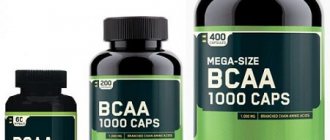- November 27, 2018
- Health
- Marina Semenyuk
Not only bodybuilders add sports nutrition to their main diet, but also those who want to build muscle mass without fanaticism. Therefore, it is necessary to know how to take amino acids and protein to get only the benefits. Moreover, there are many varieties of them.
General characteristics of sports nutrition
Those who are determined to get their body in shape don't necessarily have to turn to supplements. Their essence is to accelerate sporting achievements depending on the goal.
There are several types of such additives:
- various types of protein;
- gainers;
- amino acids;
- fat burners;
- creatine;
- preparations for joints and ligaments.
Amino acids deserve special attention. They are an integral part of protein, so the principle of their “work” is similar to the digestion of protein. They are necessary for muscle growth and body recovery after physical activity. A lack of amino acids can lead to a deterioration in health and general condition.
Thanks to drugs containing such additives, you can increase strength and endurance, improve recovery after hard training, “dry out” or, conversely, build muscle mass. Therefore, athletes consult with coaches on how to take amino acids in tablets or other forms, in what doses and how often.
Bcaa during exercise
Any physical activity
requires energy. Each cell of the body is provided with the necessary amount of energy thanks to the biological mechanism of energy homeostasis. The source of energy is glucose and fatty acids. In order to stimulate the process of energy release, the homeostasis mechanism includes growth hormone (encourages fat depots to release energy) and insulin (this hormone is important for the absorption of glucose, in turn, glucose, entering the blood, itself stimulates the production of insulin).
As soon as the level of glucose in the blood decreases, the body tries to return its level to normal and therefore begins to release energy from the reserve glucose reserve - muscle glycogen. In addition to glycogen losses, the level of essential amino acids (primarily leucine, isoleucine and valine) also decreases. Thus, the process of catabolism starts and muscle tissue is destroyed.
However, if you find another, alternative source of energy for exercise, catabolism will slow down. So, for example, when taking BCAA during training, the athlete’s body actively oxidizes the amino acid leucine, which is part of the complex, adding new, no less powerful energy to the existing “glucose” energy.
So, taking BCAA during training is justified as:
- source of alternative energy for the training process;
- a way to preserve muscle mass during heavy, long-term exercise (BCAA prevents muscle breakdown by slowing down catabolism).
Evidence of increased performance during training due to BCAA has not been supported by experimental medical evidence.
Is it possible to drink bcaa during training? Taking BCAA's during exercise is not as common as before and after exercise. However, do not underestimate the importance of using BCAA amino acids during training. They participate in energy metabolism during muscle work, as a result of which their loss during exercise can negatively affect the effectiveness of the training process and the achievement of the desired result. A number of sports nutrition products from the category for use during training include BCAA amino acids in their composition and they play one of the main roles. This solves the problem of replenishing and feeding muscles with building material directly during physical activity.
httpv://www.youtube.com/watch?v=embed/qI67iNOHBMY
How much Bcaa to take? Professional trainers note that for every kilogram of an athlete’s own weight there should be about 33 mg/kg of leucine. The ideal single dose is 4 to 8 grams for both muscle gain and weight loss. In addition, according to research, the complex demonstrates excellent effectiveness even when mixed with a protein shake. To enhance the effectiveness of the composition, you can add a little sugar to it: glucose accelerates the breakdown process and ensures a rapid supply of nutrients to muscle cells.
Types of amino acids
There are 3 groups of substances:
- irreplaceable (not synthesized by the body, comes from outside);
- conditionally irreplaceable;
- nonessential amino acids.
Group I (essential amino acids) includes:
- Tryptophan. Its deficiency causes cancer and diabetic diseases, as well as tuberculosis.
- Threonine. Necessary for maintaining protein balance, immune stability, collagen and elastin production.
- Leucine. An insufficient amount leads to deterioration in the functioning of the kidneys and thyroid gland. In addition, body weight decreases.
- Valin. With a small amount of it, the functioning of the nervous system and coordination of movements are disrupted.
- Lysine. A small amount leads to disruption of blood circulation and growth processes.
- Phenylalanine. Indispensable in the prevention of phenylketonuria.
- Methionine. Helps prevent severe functional disorders, ensures normal growth and biosynthesis of cysteine.
- Isoleucine. Supports growth processes.
Group II (conditionally essential amino acids) includes:
- arginine;
- tyrosine;
- proline;
- cysteine;
- histidine;
- glutamine
Group III (nonessential amino acids) includes:
- serine;
- glycine;
- aspartic acid;
- alanine
Each of these amino acids should be present in the human diet, since it performs its own functions. Athletes often confuse BCAA with a complete complex. The advertised drug contains only 3 interconnected amino acids: leucine, valine and isoleucine.
As a rule, the manufacturer focuses on the creation and use of essential substances, since they are not produced by the body or are synthesized in small quantities. In each complex, the percentage of amino acids varies depending on the goal.
Few people know how to take amino acids and what they are needed for. But everyone should understand that the diet must be balanced. Sometimes it is unnecessary to consume sports nutrition. Amino acids are found in foods, but not always in sufficient quantities.
Amino acids and their role in the body
Protein and proteins are the main components of human cells. A diet that contains protein compounds helps a person restore lost reserves. Proteins vary in their value, and some are completely useless. The value is the presence of amino acids in the composition.
Amino acids are synthesized from proteins obtained from food, essentially they are structured compounds formed from proteins. There are 150 different species known to science. For the normal functioning of the human body, only 22 are needed, but the human body has learned to produce only 12 of them on its own, 2 are partially replaceable, and the remaining 8 are irreplaceable, the body receives them only from food, and cannot produce them on its own.
The body synthesizes protein from amino acids necessary for the construction of tissues. Another function can be called their indispensability in ensuring normal brain activity. They are neurotransmitters. Through them, nerve signals are transmitted between brain cells.
All vitamins and minerals will be fully absorbed if there is a sufficient amount of all necessary amino acids.
- Alanine – nourishes the central nervous system with energy. Thanks to it, antibodies are produced and are responsible for immunity. Helps with the breakdown of sugars and organic acids.
- Arginine – promotes metabolic processes in muscles, regeneration of cartilage tissue, skin rejuvenation, strengthening of the myocardium and ligaments, supports immunity, slows down tumor processes.
- Asparagine and aspartic acid are required for the functioning of the central nervous system.
- Valine – supports nitrogen metabolic processes.
- Gamma-aminobutyric acid – it is necessary for epileptic seizures and arterial hypertension.
- Histidine – helps protect the body during radiation exposure, has a hematopoietic function, and supports the protective properties of the immune system.
- Glutamine – provides the desired ratio of acid and alkali. Effective in the treatment of alcoholism and tobacco smoking.
- Glutamic acid is simply irreplaceable for the treatment of ulcers and muscular dystrophy.
- Glycine – helps to heal damaged tissues.
- Isoleucine – regulates blood glucose levels.
- Leucine - helps restore and heal muscle tissue, skin and bones.
- Lysine is needed to absorb calcium. Maintains heart muscle tone, increases the body's resistance, and removes cholesterol plaques.
- Methionine - will help cure allergic reactions to chemicals and osteoporosis.
- Proline – helps strengthen the myocardium.
- Serine – maintains the balance of fats and fatty acids.
- Taurine – promotes the synthesis of bile acid, needed for hypoglycemic disease and atherosclerosis.
- Threonine – increases the body’s defense response, regulates protein-fat metabolism.
- Tyrosine - will be of great benefit in the treatment of chronic fatigue, the thyroid gland needs it and is needed for the synthesis of adrenaline and norepinephrine.
- Tryptophan is necessary for people with heart disease to treat insomnia. Promotes the production of vitamin PP.
- Cysteine - helps with rheumatoid arthritis, is widely used for cancer and arterial diseases.
- Phenylalanine – helps blood flow, treats migraines, improves memory and attention. Necessary for the production of insulin. Effective in cases of depression.
Types of amino acids by release form
Conventionally, there are 2 groups of substances: isolated and complex. In fitness and professional sports, as a rule, the latter type is used. Such amino acids saturate muscle tissue as much as possible.
Depending on what goals and objectives the athlete has set for himself, the appropriate form of release is selected. There are:
- Free L-isomers. The most valuable variety because it is completely absorbed by the body. A significant disadvantage is the high cost.
- Hydrolyzate. Its characteristics are almost the same as the previous ones, only it is absorbed more slowly.
- Di-, tri- and peptides.
Manufacturers supply amino acids to the market in the following forms:
- pills;
- capsules;
- powder;
- liquid form;
- injections.
Experts say that if you take amino acids in liquid form, they will be absorbed much faster than other varieties. The fact is that 15 minutes after the substances enter the body, they begin to participate in metabolic processes. Powdered amino acids are absorbed within 30 minutes, while tablets and capsules take much longer.
Types of amino acid complexes
BCAA complex
The complex should be taken along with regular amino acids after anaerobic training with moderate or heavy loads. Anaerobic training is powerful short-term loads with a small number of repetitions. In particular, similar training for bodybuilders.
During aerobic training, taking this complex is not effective. This does not mean that such athletes do not need to restore their amino acid supply at all. Complete amino acid complexes will give a greater effect.
The BCAA complex consists of valine, isoleucine and leucine - these are essential amino acids. When playing sports, intracellular energy is consumed because glycogen does not enter the cells. First, ATP is consumed, then creatine phosphates, and finally BCAAs. At low loads this complex is not used.
During powerful anaerobic training, BCAA is mainly consumed; at the end of training, acute BCAA deficiency appears. Muscle tissue consists of this complex and synthesis does not occur. If BCAA is not supplied from the outside, existing BCAA molecules are destroyed and new ones are produced. BCAA deficiency can cause catabolic processes in tissues. To avoid such a reaction, after completing training, the use of a ready-made BCAA complex is recommended.
Complete amino acid complexes
This group consists of complexes that include all amino acids. Their composition is balanced and completely ready for the production of new muscle tissue molecules. Any athletes can use such complexes, and the sport they engage in does not matter at all.
The reaction of your body will help you figure out which complex you need to resort to. You need to use the complex that better restores the body.
Functions of amino acids
Such supplements are used not only during muscle gain, but also during “drying”:
- amino acids allow muscles to grow at an accelerated pace;
- the protein is delivered to the muscle fibers in a timely manner, so the latter are not destroyed.
Experts advise consuming amino acids regardless of sports activities. Taking them will have a positive effect on the body's metabolic processes.
What can a lack of amino acids lead to:
- loss of appetite;
- developmental and growth delays;
- hair loss;
- anemia;
- general deterioration of physical condition.
You need to remember how to drink amino acids in the correct dosage so that their excess does not lead to disastrous consequences:
- hypertension;
- diseases of the joints and cardiovascular system;
- development of stroke and heart attack;
- disorders of the thyroid gland;
- early gray hair.
What are BCAA's for?
The main effect of BCAA on the human body is the construction of muscles, so an athlete who takes amino acids after training gives the muscles building material that provokes them to grow. There are many more beneficial properties of amino acid supplements, which are taken in the following cases.
For weight loss (fat burning)
Taking BCAA for weight loss allows you to saturate the blood with amino acid molecules, as a result of which muscle destruction processes do not occur during a low-carbohydrate diet and strength exercises. After all, during a diet, a person losing weight has a low level of glycogen, obtained from glucose, which causes rapid fatigue. Therefore, the body breaks down muscle fiber for energy. If you remove carbohydrates from your diet, fat is burned along with muscles. BCAA amino acids make it possible not to worry about catabolism during weight loss.
httpv://www.youtube.com/watch?v=embed/3EbpqP0_4vA
To build muscle mass
Taking BCAA to gain muscle mass gives the athlete the necessary energy reserves that he wastes during strength or aerobic training
Also, without the required amount of amino acids, there will be no muscle mass gain, which is important for bodybuilders. Improving the training process, athletes take protein shakes, gainers and fat burners to build muscle mass on non-training days, and drink BCAA before and after training
For immunity
BCAA is also great for boosting immunity. Every workout is stressful for the body. The more intense the exercise, the more the body needs amino acids, the lack of which reduces immunity. The BCAA complex is necessary for recovery after training, especially during mid-season weather fluctuations. Scientists have proven that taking a dietary supplement will strengthen the immune system even for people who do not exercise.
To release glucose
You need to take BCAA so that amino acids help the body produce the hormones leptin and insulin, which are involved in metabolism, control appetite, and regulate glucose levels. After amino acids are converted into glucose, they become an alternative source of energy for the athlete. Since BCAA amino acids enhance the release of insulin, protein synthesis begins after taking them even in the absence of it in the body.
As a source of glutamine synthesis
Taking the supplement allows the body to produce glutamine, which affects anabolic processes. Without glutamine, high-quality restoration of muscle tissue after strength training is impossible. Thanks to the intake of a complex of amino acids, the glutamine necessary for an athlete is synthesized directly in the muscles.
Proper supplement intake
According to scientific research, there are 4 periods when you need to take amino acids:
- Before starting your workout. Good “recharge” will allow the muscles to give 100%. By taking amino acids 30 minutes before training, the body's endurance and strength increase. At the same time, muscle fibers withstand greater load.
- During training. Since the body intensively consumes amino acids during physical activity, supplements replenish the deficiency of nutrients in the shortest possible time.
- After training. 20 minutes after sports, the body needs additional fuel. In this case, the supplements are completely absorbed. Especially muscle mass requires protein. Amino acids saturate the body with protein and launch the necessary processes.
- Before bedtime. If a bodybuilder is gaining muscle mass, then he already knows how to drink amino acids correctly. During night rest, the body requires substances that have an anti-catabolic effect. Recovery processes are intensified, and muscle growth increases.
If there is an urgent question about the presence of supplements in relation to the main meal, then experts advise taking them 30 minutes before or after meals. The drug should be taken with plenty of water.
Contraindications and side effects
First, let's highlight the disadvantages of these amino acids:
- The level of vitamin B in the body is significantly reduced by taking BCAAs. This vitamin is necessary for the metabolism of amino acids. When taking BCAAs, be sure to eat foods high in these vitamins.
- The level of seratonin in the body decreases after taking an increase in the level of amino acids in the body. This is a hormone of joy, it calms, maintains normal mood and affects the quality of sleep.
The product is contraindicated:
- Persons under 16 years of age. A teenager’s incompletely formed organs should not be exposed to any drugs without a doctor’s prescription;
- People with kidney disease, cardiovascular system;
- Pregnant women and nursing mothers;
- If you are allergic to the drug. This can be understood by starting with small doses;
For beginners who decide to start taking BCAAs with little experience and not yet significant results in sports, many trainers advise:
- Start taking any amino acids or proteins no earlier than a year after starting to play sports;
- Start using BCAA only in case of a global increase in load;
- Take strictly after talking with a nutritionist;
- Create a table from which you can observe the content of substances important for the body in ordinary food products.
- Try to get the substances your body needs from natural products;
The market currently offers a wide selection of drugs with BCAA, the product is safe when taken correctly, and its effectiveness has been proven. You should trust only trusted manufacturers and buy the product at specialized sports nutrition outlets or pharmacies.
Every seller should have quality and safety certificates, and there is no point in saving money on buying dubious products without the necessary documents.
Consuming liquid amino acids
Why do experienced athletes choose this supplement? Its advantage is the actual volume and form of easily digestible protein. A single dose of amino acids contains 20-25 grams. pure protein. In addition, tablets and powder are absorbed more slowly.
If the choice fell on a liquid analogue, then you need to know how to take amino acids. Use 20-40 ml of the drug per day. In other words, 2-4 tablespoons.
Since the absorption of liquid amino acids occurs within 15 minutes, they should be consumed a quarter of an hour before or after training. Some athletes use concentrate, while others make a special cocktail. This form of the supplement is convenient because it does not need to be diluted. In addition to advantages, liquid amino acids also have disadvantages: high price and necessary storage conditions.
How to calculate your individual BCAA dose
The issue of the amount of branched chain amino acids consumed is still controversial in the bodybuilding community. Some athletes believe that large dosages will only be beneficial, while others, on the contrary, believe that it is necessary to stick to minimal portions. The fact is that athletes receive a certain amount of leucine, valine, isoleucine with food. Naturally, it is not possible to calculate exact figures, therefore there are no clear guidelines for additional intake of the BCAA complex.
If you are new to bodybuilding, follow our recommendations. In previous chapters, we presented the body's daily requirement for BCAA (leucine - 8-15 g, valine - 2-6 g, isoleucine - 3-6 g). These figures are calculated for athletes involved in strength training. Each manufacturer indicates on the packaging the composition of one capsule or measuring spoon of powder. Compare the data on the jar of the complex with the daily requirement and calculate the approximate amount of supplement intake. Divide the resulting amount into 3 servings (before training, during, after). Choose your complex:
Consumption of powdered amino acids
Many athletes prefer such supplements because they have a pleasant taste, improved performance and a large amount of protein.
Before studying the question of how to drink amino acids in powder, it is necessary to clarify the norm for a particular person. The daily portion is divided into 3 doses of 1 measuring spoon. The instructions for the drug say that amino acids should be diluted with water, milk or juice in a convenient container. Also on the packaging it is additionally indicated who should take the supplement and how much. As a rule, the standard dose is 5-10 g. mixtures per day.
What are the effects of taking BCAA?
Leucine is most important for a bodybuilder, but isoleucine and valine are no less significant, since they greatly enhance the effect of the first.
Why do you need BCAA:
- to replenish energy;
- accelerating the regeneration of damaged muscles;
- blocking catabolism and stimulating anabolism, which causes an increase in muscle tissue;
- reducing inflammation;
- enhancing fat burning processes;
- increasing endurance and performance.
Thus, BCAA is a type of sports supplement that can help accelerate muscle growth and provide vigor. But it does not replace or cancel proper nutrition, which is important for muscle development.
Products containing amino acids
Why do athletes consume cottage cheese with a carbohydrate supplement after training? The answer is simple: this product contains all the essential amino acids.
The main sources of essential substances are also:
- legumes;
- nuts;
- cheese of various types;
- eggs;
- meat;
- Fish and seafood.
It is important to know how to take amino acids correctly, because each person has their own standards. This is influenced by characteristics such as climate, nature of daily activities, age, etc.
Advantages and disadvantages of BCAA
There are many benefits to using supplements, they relieve muscle pain, speed up fat burning, and slow down the breakdown of muscle cells. Taking bcaa is convenient, because before and after training you may not have time to eat.
The mixture helps vegetarians get the right amount of leucine, since the acid concentration in plant foods is low. Bcaa is effective in physical exercise that requires endurance, it significantly reduces fatigue and preserves energy.
Supplements have negative effects. As a result of consuming high doses of the mixture, the level of vitamin B decreases.
This can be prevented by reducing dosages and consuming products containing it:
- eggs;
- meat, fish, liver;
- spinach;
- parsley and other herbs;
- broccoli, beets, asparagus;
- lentils;
- bell pepper;
- oranges, melons, papaya.
The next disadvantage of bcaa is a decrease in the synthesis of the hormone serotonin. Lack of the substance causes depression and worsens mood. The concentration of the substance drops in everyone who adheres to a low-carbohydrate diet. To avoid this, it is recommended to consume beans, fruits, milk, and starchy vegetables in the evening.
httpv://www.youtube.com/watch?v=embed/nFJVI0cBOB4
Supplements satisfy hunger well; in pursuit of an ideal figure, women can start taking them, replacing most of their regular food, which has a bad effect on the body.
To prevent the negative consequences that drugs can provoke, they must be used according to the instructions, not exceeding the indicated dosages, in the hope of accelerating the expected results of training.
How to replace amino acids
Considering that many substances enter the body with food, in some cases it would not be superfluous to carry out standardization. The amino acid complex will allow you to determine the percentage of these supplements. The question of how to drink amino acids in tablets or other form remains open until it is closed. This information remains relevant for people who want to correct their figure or subject their body to serious physical activity.
Some drugs are sold in pharmacies. Such additives include: glycine, phenylalanine, methionine, glutamine. However, pharmaceutical products bring both benefit and harm. It is important to correctly combine foods in your diet: meat with vegetables, fruits, cereals, etc.
About the benefits and harms of BCAA: why men and women need it, how to take it
BCAA stands for branched-chain amino acids. This is what the branched amino acids are called in English: leucine, isoleucine and valine. These are proteinogenic substances, without which the construction of proteins is impossible. Some of them are synthesized in the body, while others are supplied with food.
BCAA belongs to the group of essential acids. The human body does not provide for their synthesis, so they can only be obtained through food or special supplements. In this regard, it is very simple to answer the question of what BCAA is needed for - to provide the body with the necessary amino acids, which can only be obtained from the outside.
What amino acids are needed for muscle growth?
The human body needs amino acids and most of them are synthesized as needed. But there are also amines that the body is not able to obtain on its own, but only through food intake or sports nutrition.
There are 3 groups of amino acids:
- Replaceable ;
- Indispensable;
- Conditionally replaceable.
Replaceable ones can be synthesized by the body without additional help; irreplaceable ones are replenished through the intake of various foods. As for conditionally replaceable ones, they are synthesized from essential amines, that is, they can only be replenished with a sufficient amount of these substances.
Glutamine
acts as a kind of fuel, which begins to act at the moment when the body is already tired. It is at this moment that physical impact on muscle tissue is most effective, and glutamine makes it possible to make it last as long as possible.
This amino acid belongs to the group of replaceable ones, that is, it is synthesized by the body independently. At the same time, additional consumption of this amine through sports nutrition will not hurt, since muscles are 60% glutamic acid.
Arginine
serves as an accelerator of protein synthesis and muscle fiber growth. This acid accelerates blood circulation, which allows muscles to quickly receive the substances necessary for growth.
There is also a BCAA
, which consists of 3 essential amino acids: valine, leucine and isoleucine. These acids have branched chains, and their task is to synthesize protein. More precisely, a complex of 3 amines helps restore protein content in cells. If there is not enough protein, then growth will occur much more slowly.
Valin
one of the main acids that is involved in the process of muscle growth. Additionally, valic acid helps the body resist cold and hot weather.
Leucine
is of great importance in the functioning of the body's immune system. But more importantly for muscles, it reduces the time it takes for protein to break down.
Isoleucine
stores energy in the muscles, which allows you to perform strength exercises for a long period of time. It also prevents the destruction of muscle fibers and restores damaged tissue.
These are the 5 main amino acids that an athlete needs to build muscle mass. They can be replenished through regular food intake, but it is more convenient and effective to take them in the form of sports nutrition.
Side effects
BCAA complexes and other amino acids containing them are good because they have virtually no side effects. Professional athletes don’t even think about whether they should take amines. Largely because they tested much more dangerous pharmaceuticals
If you use a quality product, it will never cause side effects, because amino acids are completely understandable substances for the body. Health problems can arise if you consume a low-quality product that was purchased from a dubious seller or a little-known manufacturer.
To understand which product was purchased, you need to try to dissolve 10 grams of BCAA or another complex in a glass of water. A high-quality product will not dissolve completely, and a film of small powder particles may appear on the surface.
In some cases, side effects may occur due to individual intolerance to the product. In this case, consultation with a specialist is required.
If you approach the intake of sports nutrition correctly, then you will not have to be disappointed in its use. Make your choice responsibly, buy only high-quality products and read the package label before use.
Basic forms
As mentioned, amino acids come in a variety of forms - tablets, powder, solutions, capsules and injections. The intravenous option is considered the most effective, but there is a high risk of side effects.
If we make a comparison taking into account price and quality, then the best option is liquid amino acids. Their advantage is easy digestibility, quick effect, minimum side effects, ease of dosage and administration.











